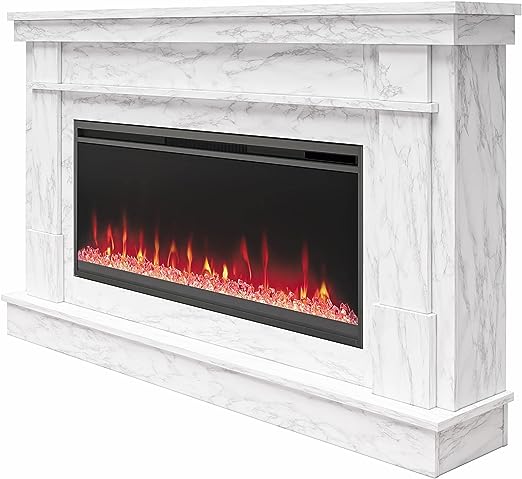How to convert a gas fireplace to an electric fireplace insert
This post may contain affiliate links which means I may receive a commission for purchases made through links.

Replacing an old gas fireplace with a modern electric fireplace insert is a fun and easy way to improve your home’s value. More importantly, it will help you enjoy the benefits of electric fireplaces and upgrade your home’s decor and ambiance.
But how exactly do you go about it? How do you convert an existing gas fireplace into an electric fireplace?
Simple! Check out this step-by-step guide to learn how to convert your existing fireplace into an electric insert.
Before we get there, let’s look at some of the benefits of converting a gas fireplace into an electric fireplace!
Why convert your gas fireplace into an electric fireplace?
First of all, as the world moves towards carbon neutrality, it’s important for all household appliances to be converted from gas to electric. However, that’s not the only thing that should make you consider replacing your gas fireplace with an electric fireplace. Instead, electric fireplaces offer several benefits you’ll not get with other types of fireplaces.
Some of those benefits include;
-
Safety
A gas fireplace comes with various risks such as carbon monoxide poisoning, especially if the room is not properly ventilated or if the gas line is damaged. Also, gas leaks can lead to explosions, although the chance of that happening is very low. On top of that, gas fireplaces cause the surfaces around them to become too hot to touch.
Interestingly, an electric fireplace does not pose any of these risks. This makes it the safest option for those with pets and kids in their homes. Besides, electric fireplaces do not produce real flames or harmful by-products. In addition, most models have a cool-to-touch front glass panel to protect your pets and kids.
-
Maintenance
A gas fireplace must be inspected before you use it for the first time. And then annually to ensure the gas line is connected properly. Moreover, you have to regularly clean it to get rid of grime build-up and check the decorative logs for damage.
In comparison, an electric fireplace provides a level of convenience that neither gas nor wood-burning fireplace can offer. Best of all, an electric fireplace is extremely easy to maintain as it doesn’t need regular cleaning or tending. However, you should turn off the unit, unplug it and wipe down its exterior with a wrung-out damp cloth from time to time to clean up any dust.
-
Cost
Installing a gas fireplace is far more costly than an electric fireplace. Not to forget that you’ll need annual maintenance costs. On the other hand, an electric fireplace is relatively inexpensive. This is because most models are ‘plug and play’ as they work with standard power outlets. Alternatively, you can contact an electrician to install the unit for you, especially if it needs to be hardwired.
-
Environmental Impact and efficiency
While gas fireplaces have a high efficiency of about 70- 90%, electric fireplaces provide a 100% efficiency since they don’t lose any heat through a vent or chimney. Moreover, electric fireplaces convert almost all electricity into heat.
As for environmental impact, electric fireplaces do not introduce ash, dust, and fine particles into your home since they’re clean. On the other hand, gas fireplaces emit fine particles and carbon emissions into the air, causing pollution.
-
Beauty
An outdated or worn-down existing gas fireplace can detract from the appearance of your home instead of enhancing its look. Luckily, installing an electric fireplace insert is a great way to update the old, ugly fireplace and add ambiance and style to your home. Even better, the best electric fireplaces are available in various styles such as modern units and traditional models that imitate the look of wood-burning fireplaces.
How to convert a gas fireplace into an electric fireplace insert
Step 1: Close the gas line
First of all, natural gas is extremely dangerous and highly flammable. For that, this step should be strictly handled by an experienced professional to prevent any accidents.
That said, look for a licensed gas fitter in your local area who has enough experience handling gas fireplaces, or check in with your preferred HVAC contractor. To start, remove the trim surrounding your gas fireplace. The contractor or gas fitter will then help you shut off the gas supply to your fireplace, disconnect the gas line and safely cap it before you remove the gas logs or gas insert. More importantly, you should apply pipe sealing around the threads of the safety cap to ensure a tight fit and prevent gas leaks, which can lead to potential house fires.
Turn the gas valve back on to check for any gas leaks. For instance, you can spray a mixture of dish soap and water around the cap. If you see any bubbles coming out at the cap, tighten or reseal it. Remember to turn off the gas shut-off valve again and leave it in that position.
Step 2: Disconnect the venting
Before you remove the gas insert from the fireplace, you need to either cut or disconnect the venting. In most cases, gas inserts are vented out the side of the house. But if the insert was installed in a wood-burning fireplace, its venting is probably in the chimney. Either way, you need to disconnect the venting from the fireplace and remove it or leave the unused terminus in place.
Step 3: Remove the gas fireplace
Some gas fireplace inserts tend to slide right out of the fireplace opening once you disconnect the venting and gas line. However, if you have an inbuilt gas insert, you may have to break the stone surround on the firebox to remove the insert.
Step 4: seal the fireplace vent
Vented gas fireplaces should be sealed to prevent warm air from escaping through the chimney. After all, this is one of the main reasons electric fireplace inserts are more efficient than both gas and traditional wood-burning fireplaces.
To seal the fireplace vent, you can either use sheet metal or a piece of plywood that is cut to fit to block off the vent or close the damper. Next, install a chimney cap at the top of the vent to create an air-tight seal.
Step 5: Run a new electrical line
Electric fireplaces consume more electricity than other household appliances like a blender or a lamp. For that, it’s important to install a dedicated outlet for your electric fireplace to avoid overloading the circuit and tripping the breaker.
Step 6: Measure the fireplace opening
Now that you have removed the gas fireplace and installed a new dedicated electrical line, the next step is to measure the fireplace opening. Specifically, you should measure the height and width of the fireplace opening.
Step 7: Find the best electric fireplace insert that will fit the opening
If the gas fireplace was installed in an old wood-burning masonry fireplace, the replacement insert should be smaller than the front of the opening as it gets smaller inside. Afterward, you can use a trim kit to cover the gaps around the electric fireplace insert.
However, if the gas insert was not part of the masonry fireplace, the hole left behind will be larger and more open, giving you more options for electric inserts. And if you still find it to find an electric insert that fits perfectly in the opening, you can use a trim kit to cover the gap.
Step 8: Insert the electric fireplace into the fireplace opening
Slide your new electric fireplace into the old gas fireplace opening and secure it in place. Then install the log set into the insert according to the manufacturer’s instructions and connect it to a 15A grounded junction box or plug it into the nearby power outlet. Lastly, install the mantel or surrounding trim, turn on the fireplace, and test different settings to ensure each function is working properly.
Conclusion
Converting a gas fireplace into an electric fireplace is ultra-simple since you don’t have to hook up gas lines or address any venting issues. Not to mention that most electric fireplace log set inserts will easily slide into the existing firebox, allowing you to get it up and running in no time.





